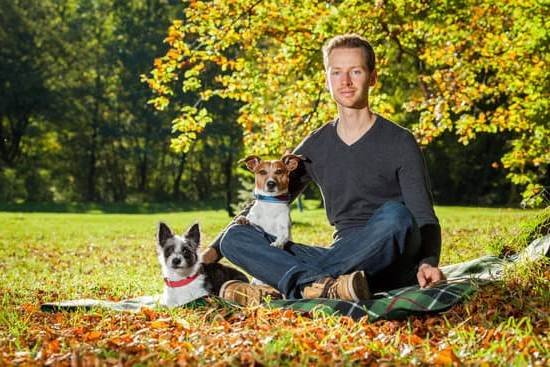Purely positive dog training is a method of teaching and shaping desired behaviors in dogs through the use of positive reinforcement techniques. It is based on the understanding that rewarding desired behaviors instead of punishing unwanted ones is more effective and humane. In this introduction, we will delve into the fundamentals of purely positive dog training, emphasizing its importance and addressing common misconceptions about this training approach.
When it comes to purely positive dog training, the emphasis lies on using positive reinforcement techniques to encourage and reward good behavior. Unlike traditional methods that rely on punishment or aversive techniques, purely positive training focuses on building a strong bond between the dog and owner by fostering trust and respect. By conditioning the dog to associate desirable behaviors with rewards such as treats, praise, or playtime, they quickly learn what is expected of them.
Although some may believe that solely using positive reinforcement creates a permissive atmosphere where rules are not imposed, this is not the case with purely positive dog training. Clear communication and consistency are crucial aspects of this approach. Training sessions should be structured and have clear objectives so that dogs understand what behavior will be rewarded. This ensures that they learn appropriate responses to commands or cues while still feeling motivated and engaged during their training sessions.
In the following sections, we will delve deeper into the science behind purely positive dog training, explore key principles and techniques used in this approach, address challenges that may arise during training, discuss its advantages, and provide answers to frequently asked questions. By understanding these fundamentals, readers will gain valuable insight into the power of positive reinforcement in creating a happier and healthier relationship with their canine companions.
The Science Behind Purely Positive Dog Training
Positive reinforcement is a fundamental component of purely positive dog training, and it is grounded in the principles of behavioral psychology. This approach to training relies on the scientific understanding of how dogs learn and the role that rewards and motivation play in shaping their behavior.
In positive reinforcement training, rewards are used to reinforce desired behaviors. When a dog performs a behavior that is followed by something rewarding, such as treats, praise, or play, they are more likely to repeat that behavior in the future. This is because the brain releases dopamine, a neurotransmitter associated with pleasure and motivation when a reward is received.
One of the key advantages of positive reinforcement training is that it taps into a dog’s natural instincts and drives. Dogs are motivated by food, play, and social interaction, and by using these rewards effectively during training sessions, owners can leverage their pets’ inherent desires to learn new behaviors. This promotes engagement and creates a positive association between learning and reward.
| Advantages | Purely Positive Dog Training |
|---|---|
| Fosters trust and builds a strong relationship between dog and owner | Encourages engagement through motivational rewards |
| Reduces likelihood of fear-based or aggressive behaviors | Taps into natural instincts and drives for effective learning |
| Promotes overall well-being and happiness in dogs | Cultivates positive association between learning and rewards |
By using rewards strategically, trainers can shape their dog’s behaviors incrementally. This technique involves breaking down complex behaviors into smaller steps or approximations. As each step is successfully performed, it is reinforced with a reward. Over time, these smaller behaviors can be combined to create more complex actions or tasks.
Understanding the science behind purely positive dog training allows owners to effectively communicate with their pets and encourage them to exhibit desirable behaviors. By utilizing rewards and motivation, trainers can tap into a dog’s innate desire to learn and shape their behavior in a positive way. This approach not only enhances the overall training experience but also strengthens the bond between dogs and their owners.
Key Principles of Purely Positive Dog Training
Purely positive dog training revolves around several key principles that not only create a strong, trust-based relationship between the owner and their canine companion but also promote effective and successful training outcomes. These principles emphasize the importance of clear communication, respect, and avoidance of punishment or aversive techniques.
One of the fundamental principles of purely positive dog training is focusing on building a strong relationship based on trust and respect. This involves creating an environment where the dog feels safe, understood, and valued. By developing a bond based on mutual trust and respect, the dog becomes more motivated to learn and actively participate in training sessions.
Clear communication is another essential principle in purely positive dog training. Dogs rely heavily on body language and visual cues to understand what is expected of them. Consistent use of clear signals and commands helps dogs understand their role in specific situations and facilitates learning. Additionally, positive reinforcement techniques such as rewards, treats, or praise can also be used as clear communication tools to reinforce desired behaviors.
A crucial principle in purely positive dog training is avoiding the use of punishment or aversive techniques. Positive trainers believe this form of training damages the trust between the dog and its owner and can lead to fear or anxiety-based behaviors. Instead, purely positive trainers focus on rewarding desired behaviors while ignoring undesired ones. This approach enables dogs to associate good behavior with rewards, encouraging them to repeat those actions consistently.
In summary, key principles in purely positive dog training include building a strong relationship based on trust and respect, emphasizing clear communication through body language and consistent signals, as well as avoiding punishment or aversive techniques. Following these principles creates a positive learning environment for dogs, fostering obedience while promoting their overall well-being.
Understanding the Role of Rewards in Positive Dog Training
Positive reinforcement is at the core of purely positive dog training methods. Understanding the role of rewards in this type of training is crucial for both dog owners and trainers. Rewards, such as treats, praise, and playtime, serve as motivators to encourage desired behaviors in dogs. By using rewards effectively, trainers can shape their dogs’ behavior and strengthen the bond between them.
One key aspect of understanding rewards in positive dog training is recognizing the different types of rewards and their effectiveness. Treats are often used as a primary reinforcement because they are highly motivating for most dogs. Additionally, praise and attention from the trainer can also be rewarding for many dogs. Playtime with toys or interaction with other dogs can also serve as valuable rewards.
Timing and consistency in reward delivery are also important factors to consider. Dogs have a short attention span, so it’s important to provide immediate reinforcement when they display the desired behavior. This helps them make the connection between their actions and the reward they receive. Consistency in reward delivery ensures that dogs understand what behaviors are being rewarded and helps reinforce those behaviors over time.
Another concept related to rewards in positive dog training is shaping behaviors through incremental rewards. Rather than expecting a dog to understand and perform a complex behavior right away, trainers break it down into smaller steps or approximations. Each step is rewarded until the full behavior is achieved. This method allows trainers to gradually shape and reinforce more complex behaviors while setting their dogs up for success.
Using rewards effectively in positive dog training not only helps train specific behaviors but also builds trust and strengthens the bond between owner and dog. Dogs learn to associate obedience with pleasant outcomes, creating a positive association with training sessions.
Common Techniques and Methods used in Purely Positive Dog Training
Clicker Training: Effective Communication with Dogs
One commonly used technique in purely positive dog training is clicker training. Clicker training relies on the use of a small plastic device called a clicker, which emits a distinct clicking sound when pressed. The sound of the click serves as a signal to the dog that they have performed the desired behavior correctly and will be rewarded. Clickers are often used because they provide an instantaneous and consistent form of communication with the dog.
Clicker training works by associating the sound of the click with a reward, such as treats or praise. The initial step involves “charging” or pairing the sound of the click with a reward so that it holds meaning for the dog. Once this association has been established, the trainer can use the clicker to mark specific behaviors that they want to reinforce.
By using clicker training, trainers can effectively communicate with their dogs in real-time, allowing for precise timing and clarity in their feedback. Dogs quickly learn to associate the click with positive outcomes and become motivated to perform behaviors that lead to receiving rewards.
Luring and Shaping Behaviors: Guiding Desired Actions
Another technique commonly used in purely positive dog training is luring. Luring involves using a treat or other desired reward to guide your dog into performing a certain action or position. For example, if you want your dog to sit, you can hold a treat above their head and move it backward until their rear end touches the ground. Once they are in the correct position, you can give them the reward.
Shaping behaviors is another powerful method in positive training. It involves breaking down complex behaviors into smaller steps or approximations and rewarding each step towards the final behavior. For instance, if you want your dog to roll over, you would first start by rewarding them for lying on their side, then progress to rewarding them for rolling slightly onto their back, and gradually shape the behavior until they can complete a full roll over.
Both luring and shaping are effective techniques because they allow dogs to think and make choices, promoting problem-solving skills while strengthening the bond between dog and trainer. These methods encourage dogs to actively participate in their training, leading to better engagement and retention of learned behaviors.
Positive Interrupters and Redirection Techniques: Managing Undesirable Behaviors
In purely positive dog training, it is important to address undesirable behaviors using methods that do not rely on punishment or aversive techniques. Positive interrupters are tools that help redirect a dog’s attention away from unwanted behaviors without resorting to force or intimidation.
They aim to interrupt the undesired behavior by providing an alternative action that is more appropriate or rewarding for the dog. For example, if your dog is jumping up on guests, you can use a positive interrupter such as a “sit” command combined with a treat rewards as soon as all four paws hit the ground.
Another technique used in positive dog training is redirection. This involves redirecting a dog’s focus from an inappropriate behavior to an acceptable one. For instance, if your dog starts chewing on furniture, you can redirect their attention to a chew toy or bone instead.
By utilizing positive interrupters and redirection techniques, trainers can effectively manage and modify unwanted behaviors while maintaining trust and respect with their dogs. These methods provide constructive alternatives to punishment, which not only helps address immediate behavioral issues but also promotes long-term behavior change through positive reinforcement.
Addressing Challenges in Purely Positive Dog Training
While purely positive dog training methods have proven to be effective and beneficial for many dogs, there can still be challenges along the way. It’s important for dog owners and trainers to be aware of these challenges and have strategies in place to overcome them. This section will discuss potential setbacks and difficulties in positive training, offer tips and solutions for overcoming challenges, and emphasize the importance of consistency and patience throughout the training process.
One common challenge in purely positive dog training is dealing with distractions. Dogs can easily get distracted by other animals, noises, or their surroundings, which can make it difficult for them to focus on the desired behavior.
To address this challenge, it’s important to start training in a low-distraction environment and gradually increase the level of distractions as the dog becomes more proficient. Additionally, using highly enticing rewards such as favorite treats or toys can help keep the dog engaged and focused during training sessions.
Impulse control is another challenge that can arise during positive dog training. Dogs may struggle with maintaining self-control when faced with tempting situations or stimuli. To help dogs develop impulse control, it’s important to practice exercises that require them to wait patiently for rewards or follow commands despite distractions. Consistency is key when working on impulse control, as repeated practice will reinforce this skill over time.
Patience is crucial when addressing challenges in purely positive dog training. Dogs learn at different rates and may have varying levels of motivation or focus during training sessions. It’s important not to rush the process or become frustrated if progress seems slow. Celebrating small victories along the way and acknowledging each step of improvement can help both the trainer and the dog stay motivated.
| Challenges in Purely Positive Dog Training | Tips for Overcoming Challenges |
|---|---|
| Dealing with distractions | – Start training in a low-distraction environment and gradually increase distractions
|
| Impulse control issues | – Practice exercises that require waiting for rewards or following commands despite distractions
|
| Maintaining patience throughout the training process | – Celebrate small victories along the way
|
Advantages of Purely Positive Dog Training
The advantages of purely positive dog training cannot be overstated. This method of training focuses on using positive reinforcement techniques to encourage desired behaviors, rather than relying on punishment or aversive methods. By implementing this approach, dog owners can enjoy numerous benefits that positively impact their canine companions.
One major advantage of purely positive dog training is its long-term effect on a dog’s behavior and overall well-being. When dogs are taught using positive reinforcement, they learn to associate good behaviors with rewards such as treats, praise, or playtime.
This not only motivates them to continue displaying those behaviors but also strengthens their bond with their owners. Positive training fosters a trusting and respectful relationship between dogs and their owners, leading to happier and more well-adjusted pets.
Furthermore, positive training methods have shown to significantly reduce the likelihood of aggression or fear-based behaviors in dogs. Punitive methods may cause fear or anxiety in dogs, which can manifest as aggression or other problematic behaviors over time. However, when dogs are trained using positive reinforcement techniques, they feel secure and confident in their environment. This helps to minimize fear-based reactions and promote a calm demeanor.
In addition to benefiting the dog’s behavior and well-being, purely positive dog training also has a positive psychological impact on the owner. Building a strong bond through positive reinforcement creates an atmosphere of trust and cooperation between the owner and their furry friend. This enhances the overall relationship dynamic and leads to increased satisfaction for both parties involved.
Frequently Asked Questions about Purely Positive Dog Training
Addressing common concerns and doubts about purely positive training techniques
Many dog owners may have concerns or doubts about the effectiveness of purely positive dog training techniques. Here, we address some commonly asked questions to help clarify any misconceptions.
Is purely positive dog training suitable for all dogs?
Yes, purely positive dog training can be effective for all dogs regardless of breed or size. The principles of positive reinforcement are based on the understanding that all dogs respond well to rewards and motivation. However, it is important to tailor the training to suit each individual dog’s temperament and needs.
Isn’t punishment necessary for correcting bad behaviors?
No, punishment is not necessary for effectively teaching desired behaviors in dogs. Purely positive dog training focuses on rewarding and reinforcing desired behaviors rather than punishing unwanted behaviors. This creates a more enjoyable learning experience for both the dog and the owner and helps build a trusting relationship.
Providing answers to questions regarding the effectiveness of positive reinforcement on different dog breeds or sizes
Can positive reinforcement work on stubborn or independent breeds?
Absolutely. Positive reinforcement can be used successfully on all types of breeds, including those that are known to be stubborn or independent. The key is finding what motivates your specific dog, whether it’s food treats, playtime, or praise. Using rewards that your dog finds highly motivating will encourage them to engage in desired behaviors.
Will my small breed require different training methods than a larger breed?
While certain aspects of training might need slight adjustments based on size differences (such as using smaller treats for little mouths), the fundamental principles of purely positive dog training remain the same for all breeds and sizes. Positive reinforcement works based on behavioral psychology, which applies universally to all dogs.
Offering recommendations for additional resources for further learning and support
If you are interested in exploring more about purely positive dog training and seeking further support, here are some recommended resources:
- Books: “Don’t Shoot the Dog.” by Karen Pryor, “The Power of Positive Dog Training” by Pat Miller, and “The Culture Clash” by Jean Donaldson.
- Online Courses: Consider enrolling in online courses on positive dog training from reputable sources such as the Karen Pryor Academy or the American Kennel Club.
- Professional Trainers: Seek out professional trainers who specialize in purely positive techniques. They can provide personalized guidance and practical demonstrations tailored to your dog’s unique needs.
By utilizing these resources and further educating yourself about purely positive dog training, you can continue to enhance your relationship with your dog while improving their behavior in a humane and effective manner.
Conclusion
In conclusion, purely positive dog training is a powerful and effective method for creating a happier and healthier dog. Throughout this article, we have explored the fundamentals of purely positive training, delved into the science behind it, and discussed key principles and techniques. By focusing on building trust and respect, using clear communication and body language, and avoiding punishment or aversive techniques, positive training sets the stage for a strong bond between you and your furry friend.
The use of rewards in positive training plays a crucial role in shaping desired behaviors. Whether it’s treats, praise, or playtime, rewards provide motivation and reinforcement for your dog. The timing and consistency of reward delivery are also essential in helping your pet understand what behavior is being rewarded. By gradually shaping behaviors through incremental rewards, you can guide your dog towards desired actions and foster their natural instincts.
Positive training offers numerous advantages for both dogs and their owners. Not only does it lead to improved behavior in dogs, but it also strengthens the bond between dog and owner. By reducing the likelihood of aggression or fear-based behaviors, positive training creates a safer environment for both the dog and those around them. Additionally, positive training techniques have long-lasting effects on a dog’s overall well-being by promoting mental stimulation, emotional satisfaction, and physical health.
Frequently Asked Questions
What is positive only dog training?
Positive only dog training is a training method that focuses on rewarding desired behaviors while ignoring or redirecting undesired behaviors. It relies on positive reinforcement, which involves providing rewards such as treats, praise, or play for good behavior. This approach aims to create a positive and enjoyable learning experience for the dog, rather than using punishment or aversive techniques.
Does positive dog training really work?
Yes, positive dog training can be highly effective. Research has shown that positive reinforcement techniques are not only successful in teaching dogs new skills and commands but also in improving their overall behavior and strengthening their bond with their owners.
By rewarding desirable behaviors, dogs learn what is expected of them and are more motivated to repeat those behaviors in order to receive the reward.
What are examples of positive punishment in dog training?
Positive punishment refers to the application of an aversive stimulus following an undesired behavior with the intention of decreasing its frequency or occurrence. While positive-only dog trainers emphasize the use of rewards and avoid punitive measures, there are some examples of positive punishment used in dog training, although they may be controversial within the positive reinforcement community.
Examples include using a loud noise or a squirt bottle to startle a dog from engaging in unwanted behaviors like excessive barking or jumping on people. However, it’s important to note that these methods need to be used judiciously and should not cause fear, harm, or distress to the dog as it conflicts with the overall philosophy of positive training approaches.

Welcome to the blog! I am a professional dog trainer and have been working with dogs for many years. In this blog, I will be discussing various topics related to dog training, including tips, tricks, and advice. I hope you find this information helpful and informative. Thanks for reading!





